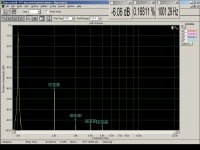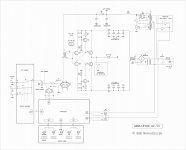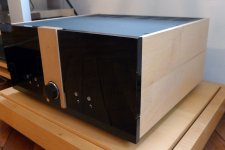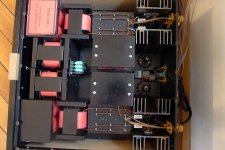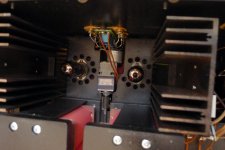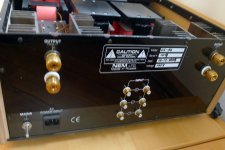Hi,
I happen to know Andrejs, he came to visit Kaunas a few times and brought that amp with him, so I had a chance to hear the thing on a few occasions. It is quite a beast, and with practically zero coloration of the sound in any direction I could notice. The many transformers are needed because of the design principle utilized. This was explained in the 6moons article better than I have the understanding to expand upon, but from what Andrejs told me, each transformer is custom made to the exact spec it will be used in the circuitry. (Not merely custom wound, but measured with an oscilloscope until it is perfect). The amp runs surprisingly cool. And it weighs like a tank. It has a remote controlled discrete volume control built in. I would be willing to bet it is the best value for the money out there. (I mean, they compared it to a Luxman which costs 10 times as much). Andrejs tells me that even Luxman didn't go to the extent that this NEM amp takes the PS.
If I can, I will gladly mediate a little bit here since Andrejs speaks German with me (we Skype often: he lives in Münster, Germany, and I live in Kaunas, Lithuania). So if there's anything I can answer regarding the design, I'd be glad to.
Louis Motek
Kaunas, Lithuania
I happen to know Andrejs, he came to visit Kaunas a few times and brought that amp with him, so I had a chance to hear the thing on a few occasions. It is quite a beast, and with practically zero coloration of the sound in any direction I could notice. The many transformers are needed because of the design principle utilized. This was explained in the 6moons article better than I have the understanding to expand upon, but from what Andrejs told me, each transformer is custom made to the exact spec it will be used in the circuitry. (Not merely custom wound, but measured with an oscilloscope until it is perfect). The amp runs surprisingly cool. And it weighs like a tank. It has a remote controlled discrete volume control built in. I would be willing to bet it is the best value for the money out there. (I mean, they compared it to a Luxman which costs 10 times as much). Andrejs tells me that even Luxman didn't go to the extent that this NEM amp takes the PS.
If I can, I will gladly mediate a little bit here since Andrejs speaks German with me (we Skype often: he lives in Münster, Germany, and I live in Kaunas, Lithuania). So if there's anything I can answer regarding the design, I'd be glad to.
Louis Motek
Kaunas, Lithuania
Hi all,
My name is Sergey Rubtsov, the designer of NEM. We made this amp.
I will be glad to answer Your technical questions.
Sergey
My name is Sergey Rubtsov, the designer of NEM. We made this amp.
I will be glad to answer Your technical questions.
Sergey
Last edited:
Welcome to the forum Sergey. The pictures on 6moons show a stunning amplifier -- especially with the top off 🙂
The design concept is very appealing to me as well.
dave
The design concept is very appealing to me as well.
dave
Hello NEM audio
I've read the review on 6M with great interest, and I have a couple of questions.
What is the rise time for the amp?
In its THD plot, what flares out most: even or odd order harmonics?
Is the frequency range limited by you or is it the max the amp capable of?
How much AC filtration/regulation is needed?
Thanks
I've read the review on 6M with great interest, and I have a couple of questions.
What is the rise time for the amp?
In its THD plot, what flares out most: even or odd order harmonics?
Is the frequency range limited by you or is it the max the amp capable of?
How much AC filtration/regulation is needed?
Thanks
Hi!
Sigmal rate is 10V/microsec and is restricted by the parameters of interstage transformer. We do not use feedbacks in the amplifier, and thus SR determines the upper frequency at nominal power, which is 80 kHz -3 dB.
The frequency range depends almost on interstage transformer. We specially design the transformer such that the wide bandwidth is not the primary goal, as in our opinion the transformers with middle frequency (sqrt(Fb*Ff)) 400-600 hz are the most musical.
The low frequency limit is 2.5 Hz - 3 dB.
The most important goal in our transformer design are the efficiency and low electric and magnetic losses, so the primary winding has typical DC resistance less than 3-5% of internal impedance of driving tube, and the core has big cross-section area, 16 sq.cm.
The number and spectrum of harmonics is determined almost only by the driver tube, typically it is less than 0.2%. I have attached the pic with spectrum of harmonics.
In general, there is no need for AC voltage filtration/stabilization, if AC voltage is in the range of +/- 5%. If AC power is dirty, this must be solved in each particular case.
Sergey.
Sigmal rate is 10V/microsec and is restricted by the parameters of interstage transformer. We do not use feedbacks in the amplifier, and thus SR determines the upper frequency at nominal power, which is 80 kHz -3 dB.
The frequency range depends almost on interstage transformer. We specially design the transformer such that the wide bandwidth is not the primary goal, as in our opinion the transformers with middle frequency (sqrt(Fb*Ff)) 400-600 hz are the most musical.
The low frequency limit is 2.5 Hz - 3 dB.
The most important goal in our transformer design are the efficiency and low electric and magnetic losses, so the primary winding has typical DC resistance less than 3-5% of internal impedance of driving tube, and the core has big cross-section area, 16 sq.cm.
The number and spectrum of harmonics is determined almost only by the driver tube, typically it is less than 0.2%. I have attached the pic with spectrum of harmonics.
In general, there is no need for AC voltage filtration/stabilization, if AC voltage is in the range of +/- 5%. If AC power is dirty, this must be solved in each particular case.
Sergey.
Wow i can't believe i had missed following up on this ...🙄,
Hello Sergey , fantastic bit of amplifier, my question ?
Are you saying that PS filtration is not important due to each stage having it's own transformer ?
Regards,
Hello Sergey , fantastic bit of amplifier, my question ?
Are you saying that PS filtration is not important due to each stage having it's own transformer ?
Regards,
WarmUp time...
Hi Sergey.
Since yesterday I'm a proud owner of an s/h AI-50. It is coming to song slowly now, but turned on from standby it really starts to sing only after about 3 hours. Before that it sounds a little shut-in and lifeless. After that period it gives total satisfaction and beautiful music and tone. Is this normal, or some kind of getting settling in to its new home...
best regards
bernie
Hi Sergey.
Since yesterday I'm a proud owner of an s/h AI-50. It is coming to song slowly now, but turned on from standby it really starts to sing only after about 3 hours. Before that it sounds a little shut-in and lifeless. After that period it gives total satisfaction and beautiful music and tone. Is this normal, or some kind of getting settling in to its new home...
best regards
bernie
Wow i can't believe i had missed following up on this ...🙄,
Hello Sergey , fantastic bit of amplifier, my question ?
Are you saying that PS filtration is not important due to each stage having it's own transformer ?
Regards,
I could post here some "user" comments, since I have similar masterpiece by NEM, the A300SE single-ended 300B tube amp.
Apart from the output stage (transistor at AI50 and tube at A300SE) the VAS, the PS and mechanical design principles are quite similar. The A300SE, in addition to PS chokes and interstage trafos, has also custom-made big output trafos (disigned for 4 Ohms load in my case). The prices for AI50 and A300SE are equal, and was a problem for me to decide what to order, and I decided in favour of A300SE, since apart of listening music, I wanted a kind of an instrument for audio "listening measurements", i.e. extremely detailed and transparent amp (at a cost of lower power). I have even tweaked the A300SE later on, by bypassing the relay input signal selector. This is a device that I use as a reference in my DIY activity.
Segei is not inclined to generalisations about why their products sound good, but for me it is quite obvious, choke input PS, Black Gates in PS, excellent skills in audio transformers and chokes.
Last edited:
Hi Sergey.
Since yesterday I'm a proud owner of an s/h AI-50. It is coming to song slowly now, but turned on from standby it really starts to sing only after about 3 hours. Before that it sounds a little shut-in and lifeless. After that period it gives total satisfaction and beautiful music and tone. Is this normal, or some kind of getting settling in to its new home...
best regards
bernie
The burning-in period for chokes and trafos are very long compared to typical SS designs.
In my case, essential sound improvement happened after 100 hours of "intensive" burning-in (a white noise signal taken from FM audio, amp output loaded by 4 Ohms resistors, output white noise voltage, measured by multimeter, around 5...6V RMS.
@ NEMaudio
I'll act as common Greedy Boy ... 😉
I'll not ask for more important details of your amp , just for one "simple" thing :
can you give us recipe for ,say, 2x15mH common mode choke ?
lams,wire etc.
tnx for sharing
I doubt that they are looking at forum, guess more reliable to contact them via mail indicated at their site
Î íàñ
NEM AI-50 conversion
Hi to all.
As a proud owner of an AI-50 i have heard that there is a way to change the tube type from 6E5P->6E6P. Since my tubes seem to burn out and i have some 6E6Ps lying around: HOW to do that? Im no electronis guy, but it should be possible with a single pin-resoldering. But which one? Also the 6E6P should have longer life...
If someone from NEM should read this: i bought my AI-50 s/h from Germany and i think it is an older version than the current ones with no tube-rectification, but two 6E5Ps. Was this an earlier version without EZ-81 rectification? Any upgrade possible?
Cheers
bernie
Hi to all.
As a proud owner of an AI-50 i have heard that there is a way to change the tube type from 6E5P->6E6P. Since my tubes seem to burn out and i have some 6E6Ps lying around: HOW to do that? Im no electronis guy, but it should be possible with a single pin-resoldering. But which one? Also the 6E6P should have longer life...
If someone from NEM should read this: i bought my AI-50 s/h from Germany and i think it is an older version than the current ones with no tube-rectification, but two 6E5Ps. Was this an earlier version without EZ-81 rectification? Any upgrade possible?
Cheers
bernie
Attachments
Last edited:
Any upgrade possible?
Hello, Bernie. Contact your distributor in Germany and he will help you.
NEM - Startseite
Best regards, Sergey Rubtsov.
- Status
- Not open for further replies.
- Home
- Amplifiers
- Solid State
- The NEM AI-50
